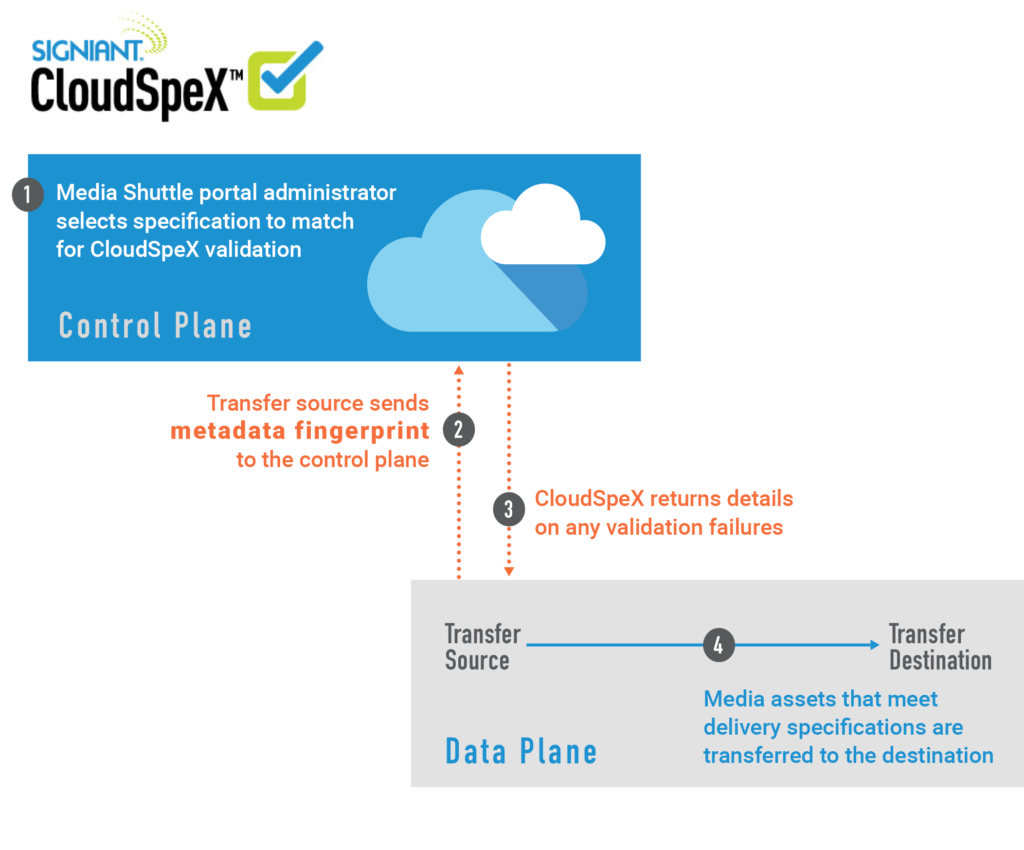Filtering Media Deliveries with Pre-transfer Asset Validation
Signiant introduces Metadata Everywhere, a new series about our innovative Software-Defined Content Exchange (SDCX) architecture and how it facilitates interactions with both media essence and metadata across disparate and distributed storage environments.
In the last installment, How Signiant’s Intelligent Transport Adapts to Provide Fast, Seamless Access to Media Assets on Any IP Network, Signiant explained the role metadata plays in its patented Intelligent Transport architecture. In this issue, we look at how our SDCX architecture extracts embedded metadata for pre-transfer asset validation.
In the mid-2000s, the media industry had a fleeting hope the SD to HD migration was also an opportunity to consolidate the world’s frame rates into one, simplifying the media world and shrinking variances and complexity. Things actually went in the opposite direction as the ecosystem now deals with many resolutions, color spaces, codecs, wrappers, and soundtrack configurations. In addition, bespoke versions, such as descriptive audio tracks, embedded closed-captions, and localization requirements compound the number of iterations.
In other words…
FRAME RATE x RESOLUTION x COLOR SPACE x CODEC x WRAPPER x SOUND SPACE = FILE FORMAT MESS6
With this complexity and increasing time pressures, the aggregation of media assets from multiple outside parties has become particularly problematic. There’s typically a very clear delivery specification in place, but ask anyone in the media supply chain whether they’ve ever received a file in the wrong format, and the answer is almost always yes.
CloudSpeX Overview
Signiant’s Software-Defined Content Exchange (SDCX) SaaS platform alleviates this problem with a unique and powerful approach. A patented capability called CloudSpeX makes it possible to determine the format compliance of a media asset before the Signiant system enables a transfer. By trapping out errors before the content ever leaves the source, aggregators can effectively push the problem back to their suppliers. Significant cost savings are possible when expensive bandwidth and QC resources at the destination are no longer consumed by the inflow of non-compliant assets. And perhaps most importantly, valuable time can be saved by eliminating the cycle of discovering an error, calling for a re-send, and starting all over again.
CloudSpeX works by automatically extracting embedded metadata at the source and sending it to the cloud, where file parameters are compared to a delivery spec stored there. Customers can choose either industry standard delivery specs such as DPP or custom-built specs for specific requirements. This cloud-based functionality is uniformly accessible to a global team or a widely distributed partner ecosystem, making it ideal for both internal and inter-company use cases.
While CloudSpeX doesn’t replace the need for automated deep inspection QC tools or human eyes at the destination, it can eliminate perhaps 90% of the problem in many situations. It’s a lightweight tool that is built into the Signiant system that’s already in place to do the heavy lifting of file movement ⎯ typically Media Shuttle, which is widely used throughout the industry for person-initiated transfers.
In order to use CloudSpeX with Media Shuttle, the portal administrator takes some simple steps to enable the functionality and choose a delivery spec for a given portal. All transfers are then subject to CloudSpeX validation, with the option to either block the transfer of non-compliant assets or to simply provide notifications to the sender. Interested parties can also be informed of failure via email.
Let’s take a closer look at the technical implementation of CloudSpeX.
Signiant’s SDCX Architecture
Signiant’s asset compliance capability is enabled by our unique SDCX architecture, which has two distinct components, a control plane and a data plane.

The control plane is the brains. It is where administrators and users interact with the system through various web interfaces. Control plane operations include access control, transfer orchestration, reporting, alerts, the brokering of inter-company content exchange, and user operations such as finding, playing, and transferring media assets. The control plane is where CloudSpeX’s file compliance specifications are administered.
The data plane deals with the media assets themselves, including the accelerated movement of assets. While the control plane is aware of all assets in the associated storage, the data plane performs ‘edge services,’ such as metadata extraction. At both ends of any Signiant accelerated transfer, there is always data plane software running in an on-premises server, on a user’s desktop, or in the cloud.
Metadata-Directed Workflow
CloudSpeX examines and extracts metadata at two levels– the package level and the file level. Package-level specifications include things like file type (extension), file quantity, and naming conventions. File-level specifications look deeper into the file’s header information.

Before transferring a file, the data plane software on the user’s workstation extracts each file’s “metadata fingerprint” and payload with a combination of off-the-shelf solutions and Signiant’s own custom metadata extractor. The metadata extraction is sent to the control plane and checked against the pre-configured specification. Validation checks for customer-defined standards might include a combination of:
- External attributes of the file including the file type (e.g. .mov, .avi, .mxf etc.) and number of files.
- Presence of specific metadata attributes (e.g., aspect ratio, video coding scheme).

The compliance check returns a pass or fail. If it does fail, the sender receives easy-to-understand information on why the files didn’t match the required specifications. If the file matches the specification, the data plane sends the file to its destination. All file compliance events are logged, and the appropriate parties are notified.

Streamlining the Supply Chain
Media companies spend valuable time and resources dealing with inbound assets that fail to meet their published delivery specifications. Signiant hears this from thousands of businesses as a growing issue throughout the media and entertainment ecosystem. By dramatically lowering the number of improperly formatted files that land at the destination, CloudSpeX saves time and money amidst the growing complexity of multiplatform delivery. It’s a built-in feature of a system that is probably in use anyway, so deployment is a snap. The number of media formats is only increasing. As supply chains continue becoming more global, complex, and time-sensitive, the headaches associated with file delivery compliance also grow. CloudSpeX is an excellent example of how Signiant’s SDCX SaaS platform helps media companies become more efficient in ways Beyond Fast File Movement.
Want to learn more about the power of metadata and Signiant’s solutions? Dive into the rest of our series here, or set up a conversation with one of our file transfer specialists to learn what Signiant’s platform can do for you.


